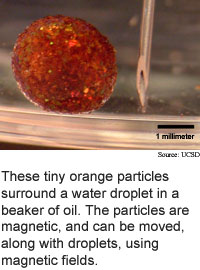
Smart dust gets magnetic
One of the main challenges in making labs-on-a-chip
is finding ways to control and mix tiny amounts of liquids.
Researchers from the University of California at San Diego are
using minuscule silicon particles to carry out these tasks.
The researchers' have modified their previously developed smart
dust by trapping magnetic iron oxide nanoparticles within the silicon
particles. The particles are chemically coated so that they adhere to
water on one side, and repel water on the other side.
The chemical coating causes the silicon particles to surround
water droplets, and the dust changes color depending on the chemicals
it is in contact with. This allows the researchers to identify chemicals
encased by the smart dust. The magnetic properties makes it possible to
move the particles -- and the droplets they are surrounding -- using a
magnetic field.
The silicon particles are 50 to 100 microns in diameter, which
is one-tenth to one-twentieth of a millimeter.
The researchers demonstrated the system by filling and draining
droplets and by combining two droplets to carry out a chemical reaction.
The system makes it possible to work with small amounts of chemicals,
and can be automated, making it possible to carry out many reactions simultaneously,
according to the researchers.
The method could be used practically in two to five years, according
to the researchers. The work appeared in the November 7, 2004 issue of
Nature Materials.
For pure nanotubes add water
Solar cell doubles as battery
Conversational engagement tracked
Pure silicon laser debuts
Briefs:
Tight twist toughens nanotube fiber
Multicamera surveillance automated
Chemical keeps hydrogen on ice
Smart dust gets magnetic
Short nanotubes carry big currents
Demo advances quantum networking

Research Watch blog
View from the High Ground Q&A
How It Works
RSS Feeds:
News
Ad links:
Buy an ad link
Ad links: Clear History
Buy an ad link
|
TRN
Newswire and Headline Feeds for Web sites
|
© Copyright Technology Research News, LLC 2000-2010. All rights reserved.